I notice at the metal gate that we drove through the night before has a small doorway large enough only for pedestrians and bike traffic to get through. I watch an employee as he leaves through it with his bike. I follow him outside the gate and am greeted with my first vision on Africa at sunrise. The people are biking or walking up and down the dirt road. One man is herding about 10 goats. A woman with a brightly colored headdress and long fitted dress is hand hoeing what appears to be nothing more than a dirt and weed plot alongside the train tracks across the road. Several people ride double on one bike. On the left, Mt. Kilimanjaro rises from the flat dusty landscape as a woman walks by me carrying supplies on her head. I am overwhelmed.
 A Springland Inn employee leaves the property at dawn in Moshi, Tanzania, Africa Saturday, February 24, 2007. (photo by Tammy McKinley)
A Springland Inn employee leaves the property at dawn in Moshi, Tanzania, Africa Saturday, February 24, 2007. (photo by Tammy McKinley) Mt. Kilimanjaro looms over the Springland Hotel in Tanzania, Africa Tuesday, March 6, 2007. (photo by Tammy McKinley)
Mt. Kilimanjaro looms over the Springland Hotel in Tanzania, Africa Tuesday, March 6, 2007. (photo by Tammy McKinley)After the other girls wake up, we go to the open-air dining room for breakfast. It is served buffet style, however the eggs are individually ordered and served by Basil. Basil wears a white button down shirt and khaki pants, speaks fluent English, and is always smiling. Breakfast is coffee or tea, fresh fruit-bananas, mangos, and pineapple, tomatoes, fried potatoes, toast, beans, and porridge.
After breakfast we arrange for a guide to take us on a nature walk through a rice plantation across the street from the hotel. Aleeyah’s English is broken, but usually understandable. We discover that is from the Maasai tribe, despite his wearing Western style clothing. Although Tanzania has over 120 tribe, the Maasai tend to be the most colorful and recognizable. They are usually dressed in bright red or purple robes and capes. Traditionally, they are polygamist pastoral nomads that rely on cattle herding for food, milk and blood and have held on to that lifestyle for hundreds of years. However, more Maasai are moving into the towns and becoming porters, vendors, and artisans. While still trying to maintain their traditional belief systems and lifestyle, the Maasai are entering the modern world of cell phones, e-mail, and materialism.
Aleeyah chats on his cell phone as he leads us across the railroad tracks, through the dirt field and into the thicket that separates the rice plantation from the road. I’m not ashamed to admit that I am a little nervous. Here we are, five suburban girls in America being led into the dense underbrush of Africa by a man we don’t know and barely understand. He walks us down a well-marked path and we meet several locals along the way. Some are carrying sticks for firewood, others carry buckets of water, and some are just walking. Soon Aleeyah leads us off the trail into to a dense patch of bush to show us what we believe he says is irrigation well for the rice fields. It is a large pool of greenish water. Some children come in from the other side of the thicket, scantily dressed and proceed to play around the pool. Just as we are leaving we hear a large splash. Aleeyah says the children aren’t supposed to play there because there are cobras and vipers in the area, but they still swim there on hot summer days. He leads us back out onto the path.
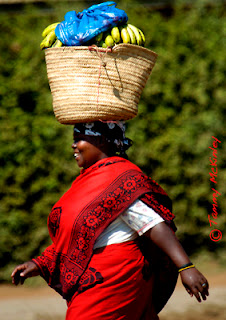 A local woman walks down the road carrying a basket of bananas on her head in Moshi, Tanzania Saturday, February 24, 2007. (photo by Tammy McKinley)
A local woman walks down the road carrying a basket of bananas on her head in Moshi, Tanzania Saturday, February 24, 2007. (photo by Tammy McKinley)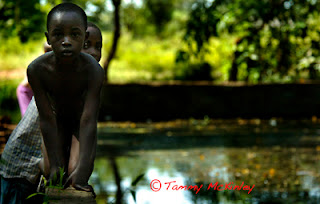 Young boys play around an irrigation well on a rice plantation in Moshi, Tanzania Saturday, February 24, 2007. (photo by Tammy McKinley)
Young boys play around an irrigation well on a rice plantation in Moshi, Tanzania Saturday, February 24, 2007. (photo by Tammy McKinley)We soon come to where the rice patties begin. We watch as a women works the field while her two young children sit under a tree nearby. Nearby, a couple of young men are throwing sticks high into a Mango tree to knock down the fruit. Everyone carries a machete. We continue on the path, walking carefully along the irrigation ridges. We have to walk single file as the ridges narrow. It isn’t long before we have gathered quite a following of curious locals. Some of the men are anxious to talk to us about America and how proud they are of their own country. We walk by a man sitting in a dead tree and most of the young men stop to talk to him as we continue our walk. The children continue to follow us, seemingly just content the walk the path with us. At one point, we are walking with about twenty other people, in single file along the ridges.
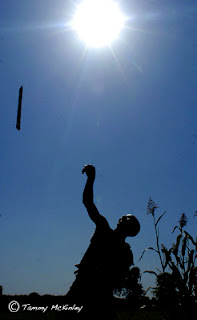 A young man throws a stick into a Mango tree to knock down the fruit on a rice plantation in Moshi, Tanzania Saturday, February 24, 2007. (photo by Tammy McKinley)
A young man throws a stick into a Mango tree to knock down the fruit on a rice plantation in Moshi, Tanzania Saturday, February 24, 2007. (photo by Tammy McKinley)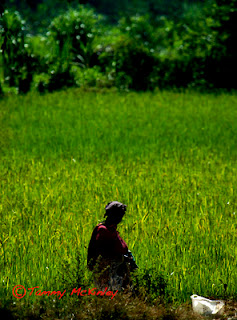 A woman works in the field on a rice plantation in Moshi, Tanzania Saturday, February 24, 2007. (photo by Tammy McKinley)
A woman works in the field on a rice plantation in Moshi, Tanzania Saturday, February 24, 2007. (photo by Tammy McKinley)We come out of the rice patties and cross a bridge into a woody area. I stop to take some pictures of women carrying loads of supplies on their head. Evidently, this is not culturally appropriate. One of the women started raising her voice and shaking her machete at me. It isn’t polite to take photos without asking or paying first. Aleeyah says something to her in Swahili and the tension is diffused.
 A woman carries sticks on her head through a rice plantation in Moshi, Tanzania Saturday, February 24, 2007. (photo by Tammy McKinley)
A woman carries sticks on her head through a rice plantation in Moshi, Tanzania Saturday, February 24, 2007. (photo by Tammy McKinley) Women carry bundles of sticks through a rice plantation in Moshi, Tanzania Saturday, February 24, 2007. (photo by Tammy McKinley)
Women carry bundles of sticks through a rice plantation in Moshi, Tanzania Saturday, February 24, 2007. (photo by Tammy McKinley)We continue down the path and see Eastern Black and White Colobus monkeys jump from tree to tree while we walk by.
Aleeyah gives each of us Maasai names. I am called Nandito, or young girl, Aleeyah takes turns holding hands with each of us as we walk along the trail. I believe this is a sign of friendship.
Aleeyah says he is taking us to a waterfall. But, when we arrive, we discover the meaning is lost in translation. It is really a dam used to irrigate the fields. An old man is there to maintain the structure. Another stops by for a drink after loading the back of his bike with tall grasses.
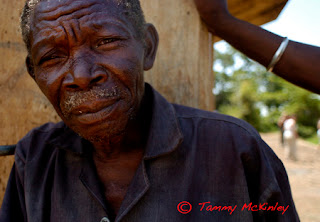 An elderly man working around the irrigation dam near a rice plantation in Moshi, Tanzania Saturday, February 24, 2007. (photo by Tammy McKinley)
An elderly man working around the irrigation dam near a rice plantation in Moshi, Tanzania Saturday, February 24, 2007. (photo by Tammy McKinley)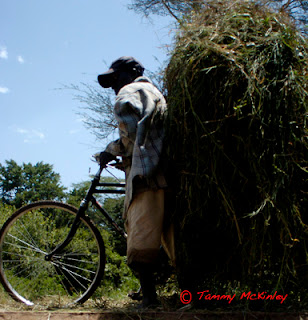 A man transports his load of tall grass for a thatched roof on the back of his bike through a rice plantation in Moshi, Tanzania Saturday, February 24, 2007. (photo by Tammy McKinley)
A man transports his load of tall grass for a thatched roof on the back of his bike through a rice plantation in Moshi, Tanzania Saturday, February 24, 2007. (photo by Tammy McKinley)On the return walk to hotel, I start to feel a little dizzy and queezy. I figure it must be the heat and the medicine I am taking to prevent malaria.
The hotel shuttle takes us to a centralized tourist area in Moshi. Moshi is the town we staying in. Its population is approximately 100-150,000 people. We are warned by the hotel not to travel without a local guide, so Aleeyah walks us through town to see the sights. He takes us by a Hindu temple, an Islamic mosque, and a Christian church, up one street and down another. The local activity is brisk with trade and traffic. There are a couple of internet cafes, people sitting on the sidewalks selling their wares, men pulling carts loaded down with wood and long grass, pushing tires down the road.
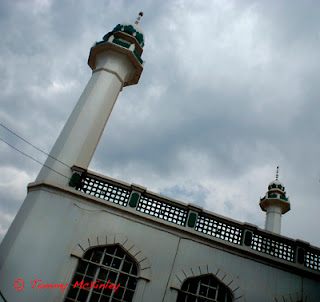 The spires of an Islamic Mosque rise above the streets in Moshi, Tanzania Saturday, February 24, 2007. (photo by Tammy McKinley)
The spires of an Islamic Mosque rise above the streets in Moshi, Tanzania Saturday, February 24, 2007. (photo by Tammy McKinley)There are no traffic lights or signals and crossing the street is at one’s own risk. Although, most people here walk everywhere or catch a ride on public transportation, the vehicular traffic is tricky to maneuver around.
 People walk along the train tracks in Moshi, Tanzania Sunday, February 25, 2007. (photo by Tammy McKinley)
People walk along the train tracks in Moshi, Tanzania Sunday, February 25, 2007. (photo by Tammy McKinley)We walk to the famous Salzburger Café for a coke. Afterwards, Aleeyah takes us to the local market. There is poultry for sale in various stages of life and food. Some are still in their pens. Some are wandering around. Some are in the process of being butchered for dinner. Fish is also being processed on site for consumption. Some of the women are selling grilled corn on a hibachi with cheese; Spices and coffees sit in huge baskets or canvas bags waiting to be measured. The market is mostly open aired. It is loosely subdivided into sections with a corrugated tin roof to provide shade for the shoppers. The activity is frenzied. People are actively trading, offering, bartering, butchering. The hum and buzz of the market stimulates the senses. The people here tend to talk on top of each other. Pauses are few until the deal is made and the parties separate to go to another vendor.
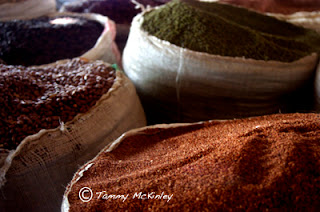 Bags of spices and beans are for sale in the open market in Moshi, Tanzania Saturday, February 24, 2007. (photo by Tammy McKinley)
Bags of spices and beans are for sale in the open market in Moshi, Tanzania Saturday, February 24, 2007. (photo by Tammy McKinley)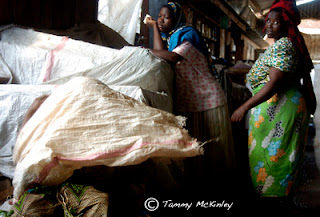 Women shop in the open market in Moshi, Tanzania Saturday, February 24, 2007. (photo by Tammy McKinley)
Women shop in the open market in Moshi, Tanzania Saturday, February 24, 2007. (photo by Tammy McKinley)Aleeyah brings us to side street to meet with some of his Maasai friends. He makes a deal with them to dance and sing for us for five dollars. About eight of the them line up. Most are in traditional Maasai dress. They begin their singing. It sounds like a forced air short breath hum, like a breathy Morse code song. They begin their dance with arms to their side bopping up and down, bending at the hip. At the height of the dance, one man steps forward and starts to do a high vertical jump with arms held at their side. These men can get some air. They continue doing this for several minutes. A crowd of about 50 local people has gathered to watch the men do this famous dance.
 Young Masai warriors hang out in an alley in Moshi, Tanzania Saturday, February 24, 2007. (photo by Tammy McKinley)
Young Masai warriors hang out in an alley in Moshi, Tanzania Saturday, February 24, 2007. (photo by Tammy McKinley) Young Masai warriors perform a traditional dance in an alley in Moshi, Tanzania Saturday, February 24, 2007. (photo by Tammy McKinley)
Young Masai warriors perform a traditional dance in an alley in Moshi, Tanzania Saturday, February 24, 2007. (photo by Tammy McKinley)When the dance is completed, I give Aleeyah the five dollars to give to the dancers. Somehow, a conflict erupts. The deal is no longer good enough. Several of the men gather around Aleeyah and begin arguing. The crowd grows larger and we can feel the danger building. The other girls in my group want to just walk away and start heading down the street. I am confused. I’ve read that Maasai are fiercely patriarchal and that a woman interfering in business is culturally taboo, but I don’t want to start trying to find our way back to the hotel without our guide. The other girls get about halfway down the street. I grab Aleeyah by the hand and pull him out of the ruckus and drag him down the street. We get a about a block and he begins laughing. We don’t really understand why, but we start laughing as well. Truly, nearly starting a riot on the streets of Moshi is a day we will never forget.
When we got back to the hotel, we tipped Aleeyah for the day. Everyone here works of tips. That seems to be the mode of pay.
Before dinner, we meet with our Mt. Kilimanjaro climb guide. His name is Teacher. He comes highly recommended by some of Joan’s friends who had climbed Kilimanjaro the year before. He speaks very good English. His real name is Lazario Edward. Everyone calls him “Teacher” because he teaches kindergarten in the off-season. He gives us our itinerary for the following day and offers several packing tips.
We leave the hotel tomorrow at 8:30 am. We are very excited about the climb and are anxious to get started.
 Ada Abalo (left) and the group mascot try to catch a few winks before boarding the connecting flight from Amsterdam to Kilimanjaro, Tanzania, Africa Friday, Febraury 23, 2007. (photo by Tammy McKinley)
Ada Abalo (left) and the group mascot try to catch a few winks before boarding the connecting flight from Amsterdam to Kilimanjaro, Tanzania, Africa Friday, Febraury 23, 2007. (photo by Tammy McKinley)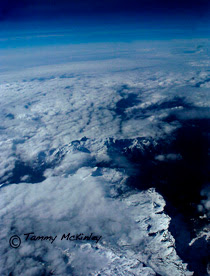 A mountian range pokes through the clouds as the plane crosses Europe on the way to Kilimanjaro, Tanzania, Africa Friday, February 22, 2007. (photo by Tammy McKinley)
A mountian range pokes through the clouds as the plane crosses Europe on the way to Kilimanjaro, Tanzania, Africa Friday, February 22, 2007. (photo by Tammy McKinley) A river cuts through the landscape as the sun sets over Niarobi, Africa Friday, February 23, 2007. (photo by Tammy McKinley)
A river cuts through the landscape as the sun sets over Niarobi, Africa Friday, February 23, 2007. (photo by Tammy McKinley) A self-portrait of me on the plane after 14 hours of flying time somewhere over the Nairobian desert in Africa, Friday, Febuary 23, 2007. (photo by Tammy McKinley)
A self-portrait of me on the plane after 14 hours of flying time somewhere over the Nairobian desert in Africa, Friday, Febuary 23, 2007. (photo by Tammy McKinley)